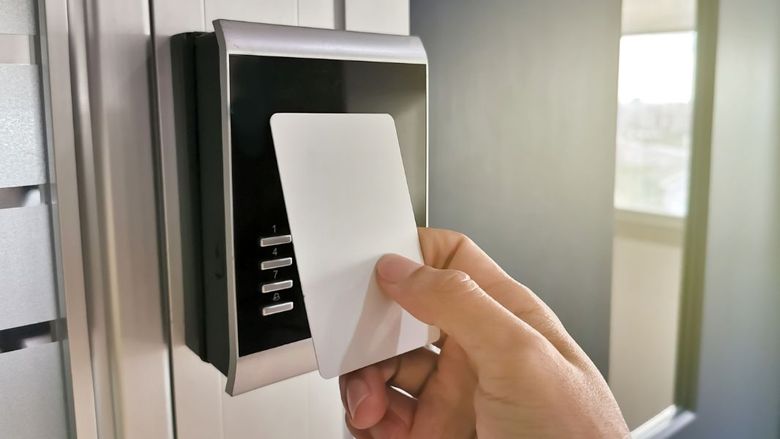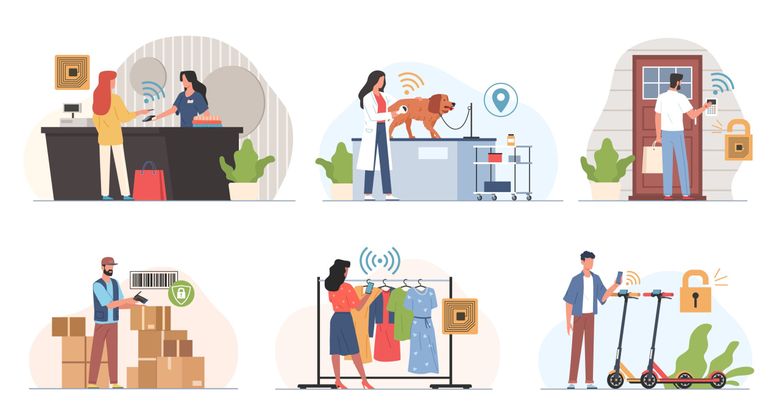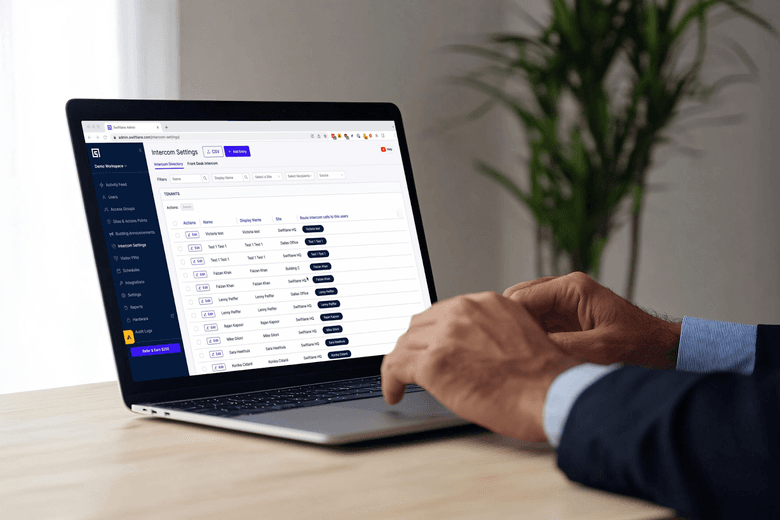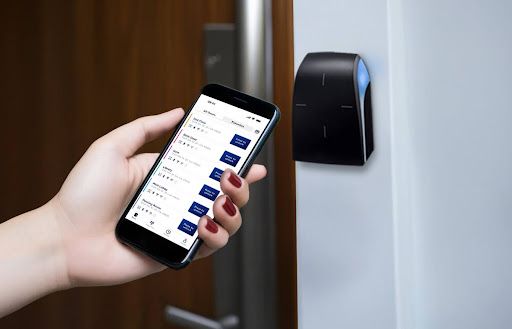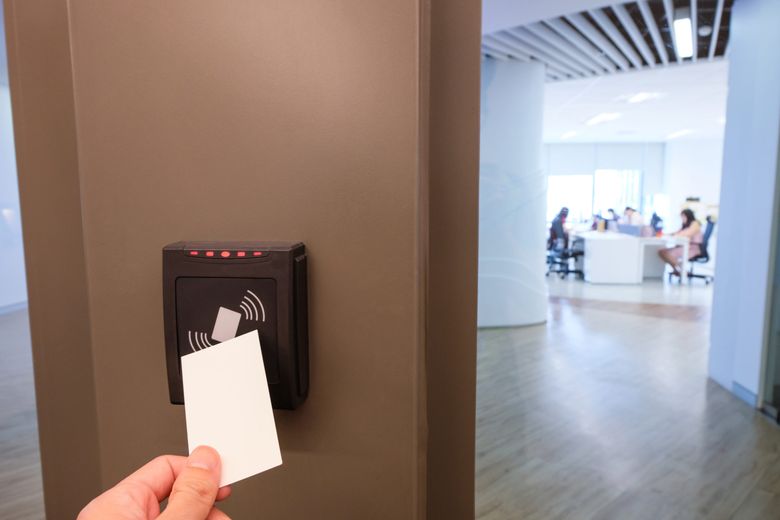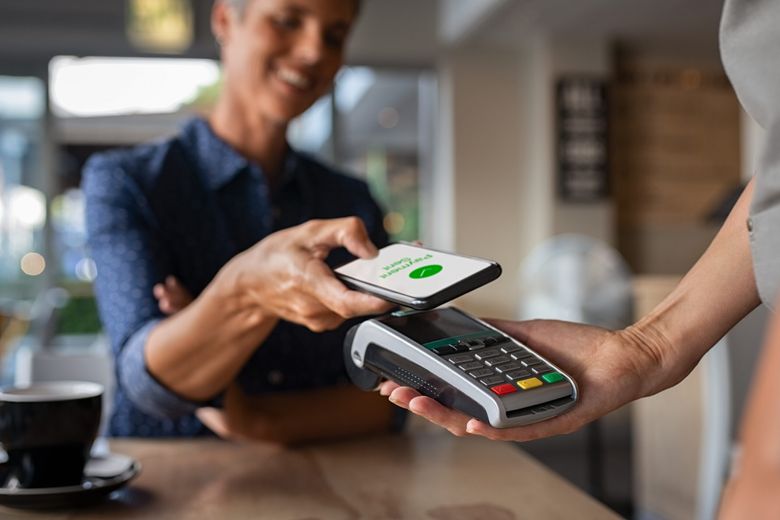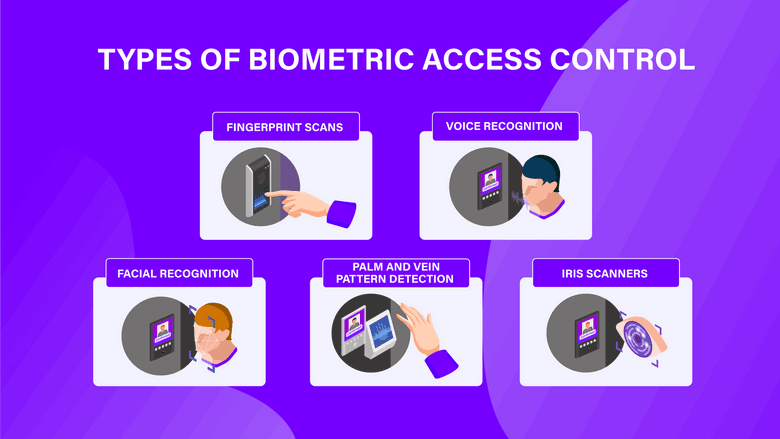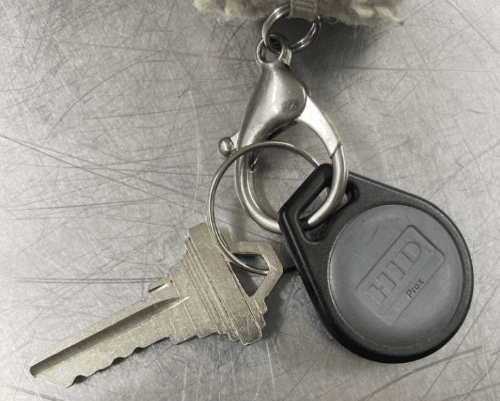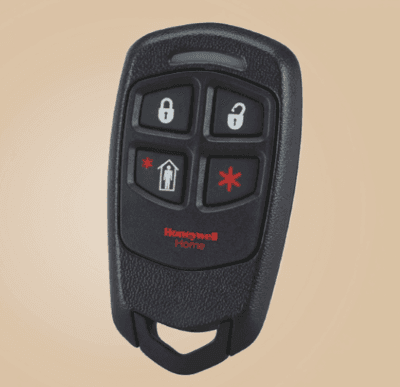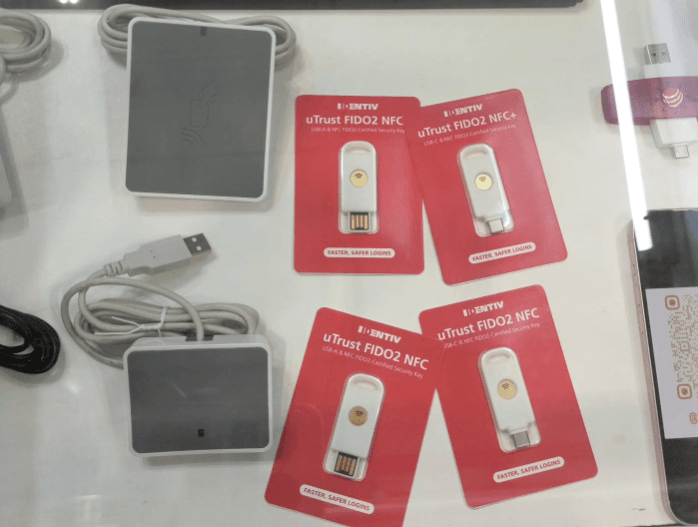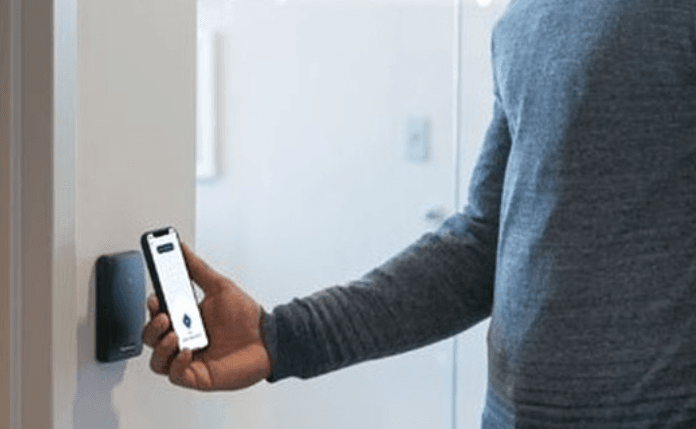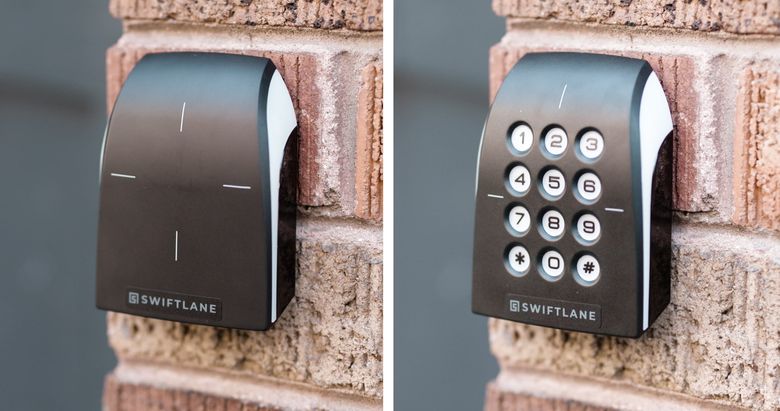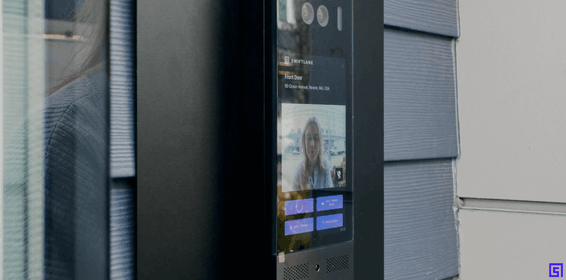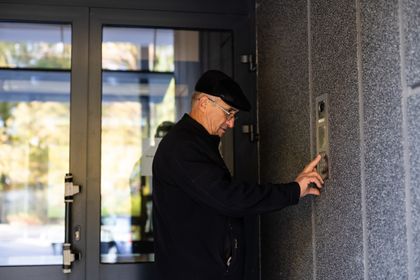For landlords, property managers, their tenants, and families alike, outdated locks and manual access just don’t cut it anymore. RFID access control systems provide a sleek, low-maintenance solution that enables secure entry faster and more easily. Whether you’re securing a private home or managing multiple tenants, RFID technology offers a professional-grade upgrade that fits modern life.
This guide covers all you need to know about RFID access control, including how it works, who it’s for, and what to know before you buy.
Table of Contents
- What is RFID Access Control?
- Why Keys are Out and RFID is In
- Who Benefits from RFID Access Control and How
- How Does RFID Actually Work
- What is NFC and How Does it Relate to RFID?
- How Radio Frequency Identification Systems Work
- What are Modern Alternatives to RFID Access Control?
- Top Makers of RFID Access Control Equipment
- What Does RFID Access Control Cost?
- How Swiftlane Can Help You Adopt RFID Access Control
What is RFID Access Control?
RFID stands for Radio Frequency Identification. It’s a technology that uses radio waves to send a unique identification code through the air from an RFID credential, like an ID card, a key fob, or a smartphone digital wallet, to an RFID proximity reader. For RFID access control, the reader can send a signal to open a garage door or vehicle gate mechanism, or to unlock a door, gate, or elevator. Think of it like a key, but one that is completely electronic, wireless, and digital.
Even if your home or workplace building doesn’t yet have RFID access control, you’re probably already familiar with it. Hotels and motels that use key cards, which you tap on the door for access, are a form of RFID. Employee badges and student IDs often use this technology. RFID’s popularity has driven it to become a $17 billion global market, which Fortune Business Insights projects will grow at an 11.9% annual growth rate through 2032 to $37.7 billion.
Why Keys are Out and RFID is In
RFID access control has clear benefits over traditional metal keys. Keys can get stolen or easily copied. If the key is copied, there’s no way to ensure the lock will be secure against unauthorized entry without changing the locks. That’s expensive and time-consuming. You’ve probably noticed that a hotel keycard stops working automatically after check-out time. You can delete RFID credentials from the system, so there’s no need to collect keys or change locks if an RFID key gets copied or stolen.
Typically, metal keys also only work with one door, meaning you might have to carry multiple keys for different doors or gates. In apartment buildings, this can become cumbersome if there are separate locks for amenities such as gyms and mail rooms. With RFID, you can program one credential to open all the necessary doors, meaning you have less to carry. Contributing to convenience, RFID cards can be used from inside a wallet, key fobs are quite small, and smartphones can have RFID credentials built in, which means all you need is your phone.
Common Applications of RFID
You will find RFID Access Control systems in a wide variety of use cases today:
- Access control for a building front door or gate, at residences ranging from single-family homes to large apartment towers.
- Outdoor gates and amenities: Secure residential amenities, such as pools, tennis courts, or parking areas, with RFID access control.
- Access control for corporate campuses and multi-tenant office buildings, including main doors, lobby gates, and elevator controls.
- Access control for residential or commercial building interior doors (storage room, mail room, gym, supply room, technical/IT room etc.)
- Vehicle windshield RFID stickers or tags open roadway and parking gates when an authorized vehicle approaches.
- Hotel/motel key cards that deactivate after check-out. Can also be used to access pools, gyms, club levels, or other hotel amenities while keeping the general public out.
- Student ID cards – for accessing dorms, dining halls, classrooms, etc.
- Securing computer terminals: Secure data and maintain regulatory compliance by locking computer terminals and granting access with the tap of an RFID credential (for instance, electronic patient records needing HIPPA compliance can be secured with RFID)
- Elevator access control: Use RFID credentials to grant access to elevator banks or auto-select floors.
- Gym access control: Use RFID to screen for authorized gym users and members.
Who Benefits from RFID Access Control and How
Property owners and building managers are coming to love RFID systems not only because they make facility management easier, but also because of the satisfaction they bring to tenants and their guests. Below is a closer look at who benefits and in what ways.
Property Owners and Building Managers
Property owners and facility managers benefit from enhanced security and streamlined management with RFID systems. By replacing traditional keys, they eliminate issues like lost keys and unauthorized copies. RFID also provides audit trails for each entry, enabling real-time monitoring and reporting.
RFID tags and key cards are durable, low-maintenance, and don’t need frequent battery changes, reducing upkeep costs. Centralized management software—whether cloud-based or on-site—allows staff to quickly update access and receive alerts for suspicious activity. Many systems also integrate with video surveillance and alarms.
Different access levels support internal controls and safety compliance. Usage data from RFID readers helps optimize staffing, maintenance, and energy use. Ultimately, RFID systems boost tenant satisfaction, support high occupancy, and can improve property value while helping lower insurance costs.
Employees and Residents
For individuals such as office employees or apartment residents, the benefits are immediate. With a quick tap of a card or a key fob, individuals can open doors, enter garages, or access elevators. There is no need to carry numerous keys on rings or remember access PIN codes. You can use a single RFID credential to grant access to multiple areas, providing a seamless experience throughout the property.
If a card or fob is lost, you can deactivate it immediately after notifying the building management and issue a replacement without disrupting the rest of the system. This eliminates the time and cost involved in changing physical locks or issuing new keys.
Visitors and Contractors
For locations that receive guests, vendors, or temporary staff, RFID systems simplify the process of granting and revoking access. One can issue temporary cards or digital credentials quickly (in coordination with visitor management systems) and restrict specific areas or time frames. Once the visit ends, your credential is automatically disabled, which reduces the chance of unauthorized reentry.
This is especially helpful in schools, hospitals, event venues, and corporate campuses where there is a regular flow of external visitors.
How Does RFID Actually Work
With any RFID system, there are two main components. First, there are RFID Credentials (sometimes also called tags). These are digital devices that store a unique identification code on a tiny microchip, which is attached to an antenna. The chip and antenna can be embedded in a variety of formats, including key fobs, rectangular cards like an ID badge or hotel key, and smartphones with a digital wallet (see NFC below).
These RFID credentials must be brought within the range of a Proximity Reader. This device combines a transmitter and receiver to detect the presence of a credential and validate its unique code.
Beyond these basics, there are three types of RFID technology in use:
Passive RFID
Passive RFID is the most common, including most key fobs and plastic cards. These credentials have no internal power source or battery, so they’ll never “run out of juice” or stop working. With these systems, the RFID reader emits a radio frequency signal, which creates an electromagnetic field. When the tag enters this field, its antenna captures energy from the reader’s signal. This energy powers up the microchip inside the tag just long enough to send back data, typically a unique ID. Communication is usually one-way; the tag responds only when energized by a reader.
Active RFID
With an active system, an internal battery powers both the chip and the signal transmission. Tags can broadcast signals periodically, even without a reader nearby. Tags can therefore initiate communication or be “seen” by a reader from far away, which can be helpful for applications like cars approaching a vehicle gate or toll booth. Active RFID can also send more data, sometimes including sensor readings (such as temperature and movement), which can be helpful in applications like inventory management rather than access control.
Semi-Passive RFID
Semi-passive RFID credentials include a battery, like active tags, but they do not transmit signals on their own. The battery powers the chip and any sensors. The tag waits for a reader’s signal (like a passive tag), but because it’s already powered, it can respond more quickly and with more data. You may often see them in sensor-based applications or when a stronger signal is needed without the constant broadcasting of active RFID.
What is NFC and How Does it Relate to RFID?
Beyond understanding active, passive, and semi-passive RFID, one of the need-to-know types of RFID these days is Near Field Communications (NFC). In recent years, this has become a widely used form of radio frequency identification, commonly built into credit cards and smartphones.
NFC is a short-range form of RFID operating at 13.56 MHz that allows two-way communication between devices. It’s commonly used in smartphones and payment systems. While all NFC is RFID, most RFID systems (especially UHF and long-range types) are not NFC. Contactless payments, such as Apple Pay and Google Pay, utilize NFC. Access control devices that allow you to tap your phone or smartwatch at the door or gate to unlock it are also typically NFC-enabled (Bluetooth can also serve as an alternative to NFC).
How Radio Frequency Identification Systems Work
Radio Frequency Identification (RFID) technology comes in various types and protocols, each suited for specific applications based on range, power source, and data exchange methods. Here’s a breakdown:
Types of RFID Systems (by Frequency Band)
In this section, we cover the nitty-gritty of the underlying radio frequency technology for those who might want detailed knowledge of different RFID radio bands.
1. Low Frequency (LF) – 30 kHz to 300 kHz
- Typical Frequency: 125–134.2 kHz
- Range: Up to 10 cm (you need to bring the credential close to the proximity reader)
- Use Cases: Animal tagging, car immobilizers, access control (e.g., key fobs)
- Pros: Works well around water and metal
- Cons: Short range, slower data transfer
2. High Frequency (HF) – 3 MHz to 30 MHz
- Typical Frequency: 13.56 MHz
- Range: Up to 1 meter
- Use Cases: Smart cards, ticketing (e.g., transit systems), library systems, NFC (a subset)
- Pros: Better range and speed than LF
- Cons: More sensitive to interference from metals
3. Ultra High Frequency (UHF) – 300 MHz to 3 GHz
- Typical Frequency: 860–960 MHz (region dependent)
- Range: Up to 12 meters (passive), 100+ meters (active)
- Use Cases: Inventory tracking, logistics, toll collection, warehouse management
- Pros: Long range, fast data transfer, bulk reading
- Cons: More prone to interference; requires line-of-sight in some cases
4. Microwave RFID – 2.45 GHz or 5.8 GHz
- Range: Similar or longer than UHF
- Use Cases: Vehicle tracking, high-speed toll booths
- Pros: Fastest data rate
- Cons: High interference, costly, less common
In addition to frequency, RFID is also transmitted using various protocols or standards that have been developed over time and are published by the International Organization for Standards (ISO). This aspect of the technology gets a bit more technical than is needed for our purposes, but if you’d like to learn more, you can read about them here.
What is Wiegand and How Does it Relate to RFID?
Wiegand doesn’t refer to an RFID type or protocol in the traditional radio-frequency sense, but rather to a data transmission format commonly used between an RFID reader and a controller (like a door access panel). Here’s how Wiegand fits into the RFID ecosystem:
Wiegand is a communication protocol and wiring standard developed in the 1970s, which defines how data is transmitted from an RFID or card reader to an access control system.
- Most common format: 26-bit Wiegand
- 1 parity bit + 8-bit facility code + 16-bit card number + 1 parity bit
- Other formats: 34-bit, 37-bit, proprietary variants
Many access control devices, like electronic door locks or intercoms, use Wiegand to receive data, and many RFID proximity readers transmit data to those devices using Wiegand as well. Wiegand is widely used in legacy systems, but it’s not encrypted and is relatively insecure by today’s standards. Modern systems are moving toward RS-485 (OSDP) or TCP/IP for more secure, encrypted communication.
Can RFID Credentials Be Copied?
Yes, it is possible for many legacy, unencrypted RFID tags to be copied, but it does require specialized digital equipment, making it less common than copying metal keys. If your system must prevent copying, choose a system with encrypted RFID tags or two-factor authentication.
What RFID Type is Most Secure?
RFID can use different data storage and transmission protocols, some of which are more secure than others. The most secure systems include:
High-Frequency (HF) RFID using MIFARE DESFire EV2/EV3
Use case: Secure building access, transit cards, ID badges
- Frequency: 13.56 MHz (HF, ISO/IEC 14443)
- Encryption: AES-128, DES, or 3DES encryption
- Features: Mutual authentication, secure messaging, key diversification
- Why it’s secure: These chips support secure, encrypted transactions and are resistant to cloning and eavesdropping when properly configured.
NFC (Near Field Communication) with Secure Element
Use case: Mobile payments, contactless ticketing, secure identity
- Frequency: 13.56 MHz (subset of HF RFID)
- Encryption: Uses banking-level cryptography via Secure Element (SE) or Host Card Emulation (HCE)
- Why it’s secure: NFC technology leverages existing secure ecosystems (e.g., Apple Pay, Google Pay) and can include biometric authentication, such as requiring facial identification or a fingerprint on your phone before the NFC credential can be used – a form of two-factor authentication.
iCLASS SE and SEOS (from HID Global)
Use case: Government, enterprise access control
- Encryption: AES-128, mutual authentication
- Features: Supports SIO (Secure Identity Object) model, which wraps identity data in encrypted containers
- Why it’s secure: Designed for high-assurance environments with strict physical and logical access controls.
Multi-Factor Authentication (MFA)
MFA (sometimes 2FA) involves another method of identification which uses an RFID tag. This could include entering an additional PIN code, using biometric identification such as facial recognition, or a special code from an authenticator app. Multi-factor authentication prevents unauthorized use of an RFID tag if it gets copied or stolen.
What are Modern Alternatives to RFID Access Control?
RFID access control systems are a relatively modern tool that replaces the legacy limitations of PIN codes and metal keys. However, there are even newer systems considered completely “keyless” and “hands free” with a higher level of security, such as biometric access control.
While an RFID credential could be stolen or used by an unauthorized individual, biometrics, like a fingerprint, palm scan, or facial recognition, are unique to each person and very hard to fake. Buildings seeking secure and convenient access control options might consider a building intercom with built-in facial recognition.
Top Makers of RFID Access Control Equipment
RFID has become a widely adopted technology in recent years, not only for access control but also for inventory management and vehicle tracking. There are literally dozens of companies operating in this space. We provide some basic information about five of the biggest players.
HID Global
Based in Austin, Texas, HID Global is one of the most recognized names in secure identity solutions and RFID access control. The company offers a wide portfolio that includes RFID-enabled credentials (such as cards, key fobs, and tags), readers, mobile access solutions, and identity management software. HID’s iCLASS, Seos, and Prox technologies are trusted in various sectors, including commercial real estate, education, government, and healthcare. Its mobile credential solutions, which utilize Bluetooth and NFC, enable users to unlock doors with their smartphones, making it a leader in next-generation access control.
Honeywell
Honeywell, based in Charlotte, North Carolina, is a global conglomerate with a strong presence in building automation and industrial technology. Its RFID offerings are part of its broader suite of enterprise and industrial solutions. Honeywell provides RFID readers and middleware that integrate with access control systems, warehouse management software, and logistics tracking platforms. Its technology is often deployed in high-compliance sectors like aerospace, healthcare, and logistics, where RFID is used for inventory control, asset tracking, and facility security.
Identiv
Identiv is a California-based company headquartered in Fremont that focuses on identity, security, and RFID technologies. It provides RFID-enabled physical access control solutions, including smart cards, key fobs, RFID and NFC readers, and credential management platforms. Identiv serves highly regulated sectors like the federal government, education, and healthcare. In addition to access control, the company produces specialized RFID tags and sensors used in medical devices, industrial tracking, and secure Internet of Things (IoT) environments.
Gallagher
Gallagher is headquartered in Hamilton, New Zealand, and is known globally for its high-security access control, perimeter protection, and integrated RFID systems. Its flagship platform, Gallagher Command Centre, allows centralized management of RFID-based access control across multiple sites with layered security features like biometrics and real-time monitoring. You will find Gallagher’s systems in sensitive environments such as defense, utilities, prisons, and critical infrastructure. The company is also known for strong encryption and usage in institutions with strict compliance needs.
LenelS2
Headquartered in Pittsford, New York, LenelS2 is a major provider of advanced physical security solutions, particularly in enterprise access control. Now part of Carrier Global Corporation, the company offers integrated RFID-based access systems through its OnGuard and NetBox platforms. LenelS2’s systems support various RFID credentials, including smart cards and mobile credentials. They are found deployed most often in large-scale applications like commercial buildings, airports, universities, and government facilities. The company’s hardware is routinely integrated with video surveillance and alarm systems, enabling comprehensive, RFID-enabled security management across large sites.
What Does RFID Access Control Cost?
RFID access control system prices can range widely depending on the scale, features, and infrastructure of the property. Here’s a breakdown from simple to comprehensive setups.
1. Basic RFID Door Access (Single Door or Entry Point)
A small-scale RFID system—typically a standalone key fob/card reader connected to an electric door strike—can cost between $300 and $1,200 per door. This includes:
- Reader hardware: $100–$400
- Electronic door lock or strike: $100–$300
- Controller (if needed): $150–$300
- Installation and wiring: $200–$500
These systems usually don’t include advanced software or cloud capabilities. Access is programmed directly into the hardware or through a basic local management interface.
2. Mid-Range RFID System with Local or Cloud-Based Management
For small offices, multifamily buildings, or businesses needing to manage access for multiple users or doors, expect a cost of $1,000 to $3,000 per door. This setup may include:
- Networked RFID readers
- RFID reader integrated into a building intercom
- Access control panel or edge device
- Integration with local or cloud-based software
- User mobile app (in some systems)
- Audit logs and remote credential management
Installation and labor remain significant cost factors, especially if doors need retrofitting or new cabling. If using a cloud-based management platform or a system with an integrated access control smartphone app, an additional monthly subscription fee may be required, which increases depending on the number of users in the building.
3. Full-Building RFID Access Control System
In large commercial buildings, apartment complexes, or mixed-use properties, full-scale systems may include RFID access for:
- Main entry points
- Interior doors (e.g., offices, utility rooms)
- Parking gates
- Elevator floor access control
These systems typically range from $5,000 to $100,000+, depending on:
- Number of access points (10, 50, 100+ doors)
- System complexity and integrations (e.g., with elevators, alarms, visitor management, or CCTV)
- Whether wireless or PoE-based systems are used
- Level of redundancy and failover systems installed
Hardware (controllers, readers, cabling) makes up the bulk of initial costs, along with planning, network infrastructure, and installation labor.
How Swiftlane Can Help You Adopt RFID Access Control
As a modern access control provider, San Francisco-based Swiftlane offers RFID products for a variety of use cases. We don’t manufacture the RFID hardware, but we can put components together into a comprehensive access control system for your multi-tenant residential building or office, all managed from our central Swiftlane management platform and highly rated user app. We offer:
- Stand-alone RFID proximity readers for unlocking doors and gates.
- Building video intercoms with built-in RFID key card or key fob capabilities
- Vehicle Access Control solutions include RFID windshield stickers, RFID vehicle tags, and vehicle clickers for access to garages, parking lots, and opening roadway gates.
- We also offer solutions targeted to gated communities, salon suites, and gyms.
All of our products can integrate with other access control technologies, including intercoms and PIN keypads. Hardware and RFID credentials are all managed via our easy-to-use cloud-based remote management platform. Furthermore, our system is built around a user-friendly resident and employee smartphone app, which has earned a 4.7-star and 4.8-star rating on the Google Play and Apple App stores, respectively.
Contact us for price quotes and to learn more about our RFID and comprehensive access control systems.
Start Improving Your Building Security
Contact a Swiftlane specialist and find the best access and intercom solution for your building.

